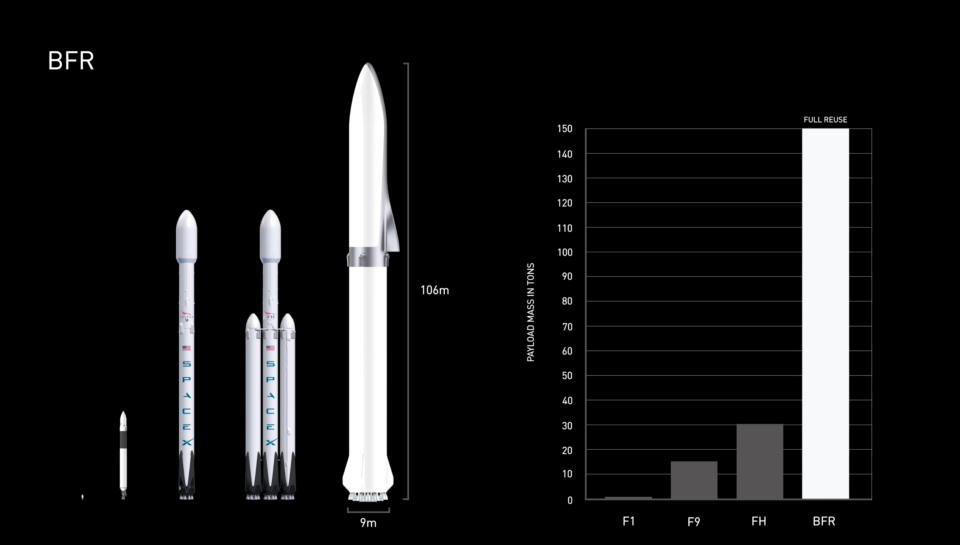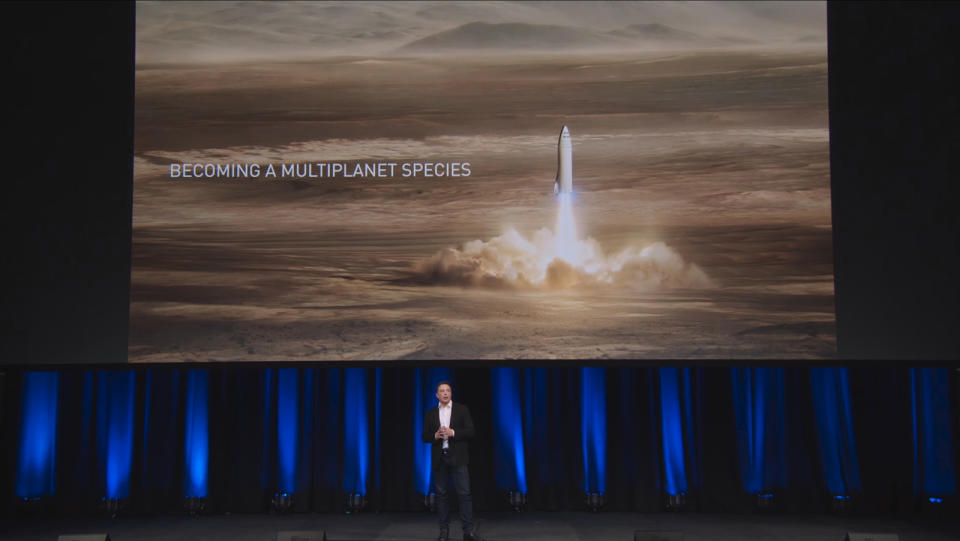Elon Musk's Mars dream hinges on a giant new rocket
Mars City, Moon Base Alpha and the BFR.
Last night, Elon Musk dumped more futuristic space tech ideas at the International Astronautical Congress (IAC) than we've had possibly over the past decade. That includes a new spaceship, Mars and Moon missions, and even using rockets for high-speed trips here on Earth. "The future is vastly more exciting and interesting if we're a space-faring civilization and multiplanetary species than if we're not," the SpaceX boss led off by saying. "You want to wake up in the morning and think, 'The future's gonna be great.'"
The presentation included elaborate plans for a moon base, an entire Mars city and 30-minute intercontinental travel, all aboard a brand-new rocket ship called the "BFR" (for "Big Fucking Rocket," we assume). All of it seems completely crazy, and incredibly expensive, but Musk told us that if the BFR were to replace all of SpaceX's current rockets, it would all be financially feasible.
The BFR ("Big Fucking Rocket")

SpaceX plans to pare down its rocket lineup from three (the Falcon 9, Falcon Heavy and Dragon) to one: a much larger rocket code-named BFR -- formerly the Interplanetary Transport System. "That's really fundamental," Musk said.
The BFR can carry more payload than any rocket ever, including the Saturn V Apollo ship. Because most of the parts will be reusable, it's also the cheapest ever, Musk claims. It would be more reliable than the Falcon 9 because it would land with two engines. "I think we can get to a landing [safety level] that's on par with the safest commercial airliners," he said. It will also be precise enough to land back on its launch mounts, eliminating the need for legs.
The BFR will have a booster and upper stage that act like the Falcon 9's upper stage and Dragon capsule in one. It features a "Delta" or small wing at the back of the rocket, with a split flap for pitch and roll control to handle atmospheric Earth and Mars landings, as well as lunar touchdowns.
The rocket itself will be approximately 106 meters (348 feet) long and 9 meters (30 feet) in diameter. Meanwhile, the second passenger and cargo stage is 157 feet long and will be able to take a payload of around 150 tons into low-Earth orbit, returning with 50 tons. By comparison, the Falcon Heavy, which has yet to fly, will carry about 30 tons into orbit.

For longer missions, the BFR second stage could be refueled in orbit by a drone "tanker" ship. It could take up to 240 passengers, but more likely around 100 people, to Mars and elsewhere. This second stage would also be equipped with a central storage section, galley, entertainment area and solar storm shelter.
The BFR will be powered by 31 Raptor engines, which run on methane and oxygen, rather than on kerosene and oxygen, like the Falcon 9's engines. That technology will make it the "highest thrust-to-weight engine ever," said Musk. Those potent engines will also be tiltable, to allow for SpaceX's trademark propulsive landings.
Musk made it all seem like no big deal, but a lot of that tech has never flown. To demonstrate progress made so far, he added that SpaceX has already tested the Raptor engines for around 1,200 seconds and showed attendees a 40-second firing test, "typical for a Mars landing."
Another challenge is the enormous cryogenic fuel tanks. SpaceX has already tested a 264,000-gallon prototype by (of course) blowing it up and launching it 300 feet into the ocean. "We now have a pretty good sense of what it takes to build a huge carbon-fiber tank that can hold cryogenic liquid," Musk cracked.
Near-term missions and the BFR

SpaceX is aiming for 20 Falcon 9 missions by the end of 2017, and 30 in 2018, "approximately half of all orbital launches that occur next year on Earth," Musk said. He also reminded us that the Falcon 9 has now completed 16 successful landings in a row.
The Falcon Heavy is apparently still on track to launch this year, adding that the project has proven more difficult than expected. "It sounds like it should be easy because it's two stages of Falcon 9 strapped on as boosters," he said. "It's actually not. But the boosters have all now been tested and they're on their way to Cape Canaveral."
Another key piece is the Dragon v2 capsule, the successor to the Dragon. The latter ship requires the astronaut-operated Canadarm for the final docking stage. Dragon v2, Musk added, "will directly dock with the space station and do so with zero human intervention." SpaceX apparently used the Dragon spaceship to help perfect the heat shields for the BFR.
When the BFR launches, it will be able to handle all of SpaceX's commercial launches, despite seeming like ridiculous overkill. It could be used to launch multiple satellites at once, or send up a space telescope much bigger than the Hubble. The BFR could even be used to collect space debris -- you just open the large bay door and scoop it up.
Moon Base Alpha and Mars City

The BFR rocket would be able to land on the lunar surface and even return through high-orbit refueling. With its huge carrying capacity, that would offer the ability to build "Moon Base Alpha or a lunar base" on the moon at some point, said Musk. "It's 2017 -- we should have a lunar base by now. What the hell's going on?" he added. The ship would be equipped with a crane, allowing astronauts to easily unload cargo.
As for Mars, it's awfully similar to the plans laid out last year at IAC, but much more concrete. SpaceX plans to send two BFR cargo missions to Mars by 2022, as Musk had detailed before. Those missions, which would also require high-orbital refueling, would "confirm water resources and identify hazards." They'd also "place power, mining and life support infrastructure for future flights," SpaceX detailed in a slide.

By 2024, it would run a pair of cargo missions and a pair of crew missions, four in total. Those would bring personnel and equipment and, most important, get a propellant production plant set up. Getting back from Mars would require fuel production, and, Musk said, it could be done relatively easily on the Red Planet by harvesting ice water from the surface and CO2 from the atmosphere.
Early Mars astronauts would also start building a base and preparing for expansion. That would start out fairly simply, but "over time, [it would involve] terraforming Mars and making it a really nice place to be," said Musk. It would also involve a large number of solar panels, which Tesla could handily supply, of course.
Intercontinental BFR transportation

The final peg in Musk's plan involves using the BFR to transport humans here on Earth. The aim is to first bring brave voyagers to sea-based rocket pads. From there, a BFR would launch to space at a maximum speed of 18,000 miles per hour, finishing with a propulsive landing back on a pad, allowing trips from Hong Kong to Singapore in 22 minutes, or London to New York in 29 minutes. The longest journeys would take less than an hour.
"Most of what people would consider to be long-distance trips would be completed in less than half an hour," Musk said. "Once you're out of the atmosphere, it would be smooth as silk. No turbulence, nothing."
This sounds crazy, right?
Somehow, all of these plans make sense coming out of Musk's mouth. SpaceX hasn't even flown the Falcon Heavy, let alone the BFR. As a reminder, it's the largest rocket ever and depends on a host of unproven technology. What's more, SpaceX hasn't really said how it would pay for all this stuff.
The plan's saving grace is that it's not coming from a wild-eyed futurist, but from Musk, who has pulled off a lot of crazy stuff that once seemed impossible. At next year's IAC, we'll probably have a much better sense of how things are going. If SpaceX can complete the 30 missions planned for next year and stick to its schedule with the Falcon Heavy, all while quickly developing the BFR -- then it might have a shot. If there are any hitches, however, expect things to get pushed back: 2022 is still five years away.




























